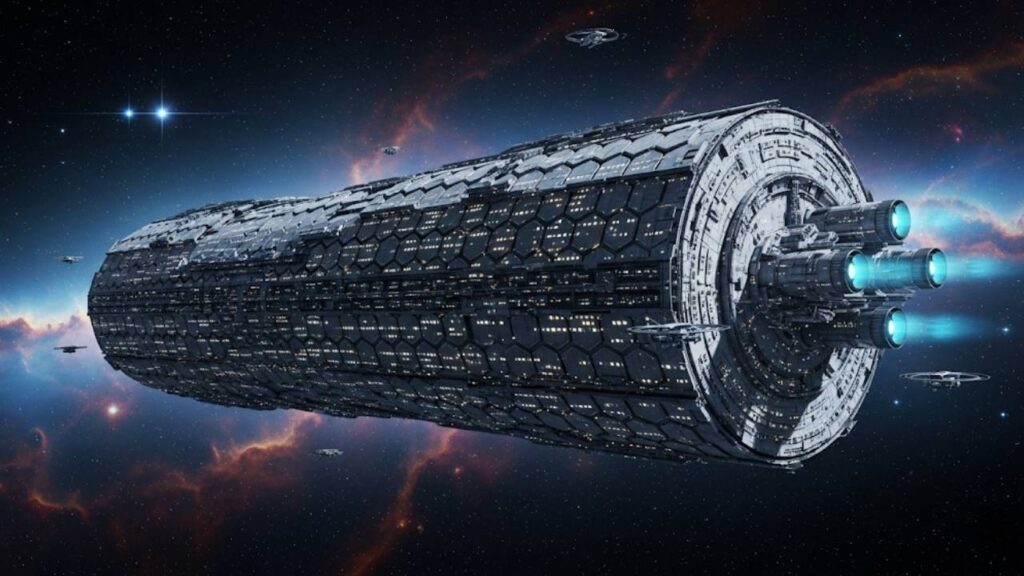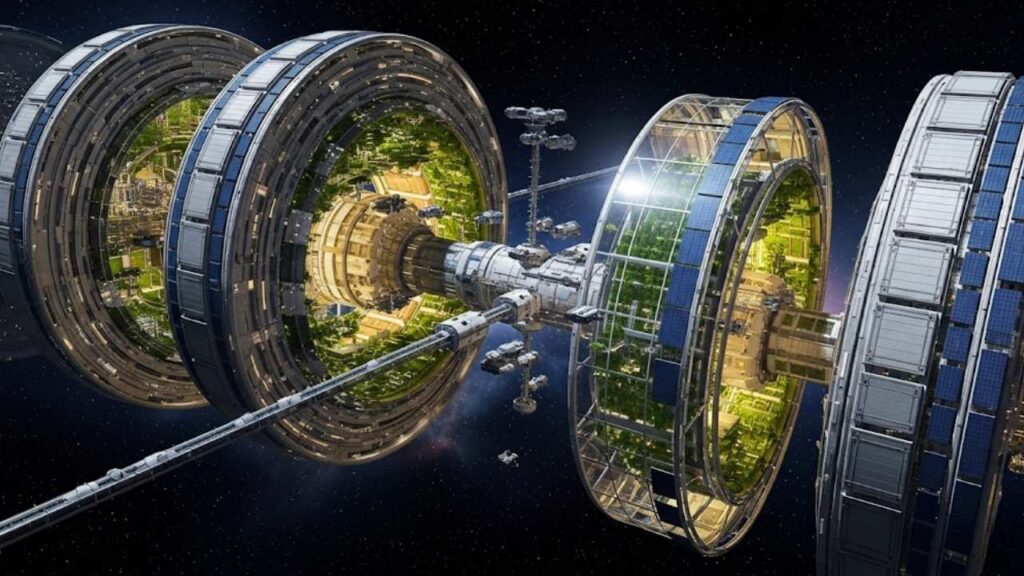The Chrysalis starship is an extraordinary new spacecraft design created to carry up to 2,400 people on a historic one-way voyage to Alpha Centauri, the closest star system to Earth. This innovative concept comes from an international team of architects, engineers, scientists, and social experts as part of the groundbreaking Project Hyperion design competition. It marks an unprecedented vision for humanity’s first effort to travel beyond the Solar System and establish a multi-generational human presence on another world.

In this article, we’ll dive deep into the fascinating details of Chrysalis, explaining its design, propulsion system, life-support technologies, and social structures that could sustain thousands of people on a centuries-long journey. Whether you’re a curious space fan or a professional interested in the future of interstellar travel, this comprehensive guide breaks down complex ideas in an easy-to-understand yet authoritative way.
Table of Contents
Chrysalis Starship
| Feature | Details |
|---|---|
| Passengers | Up to 2,400 people (optimal population around 1,500) |
| Mission | One-way trip to Alpha Centauri (~400 years travel + acceleration & deceleration phases) |
| Length | About 36 miles (58 kilometers) long |
| Diameter | Approximately 6,000 meters (6 kilometers) |
| Mass | Roughly 2.4 billion metric tons |
| Propulsion | Direct Fusion Drive (DFD) using helium-3 and deuterium |
| Acceleration | Approximately 0.1 g (0.98 m/s²) with about one year of acceleration |
| Gravity Simulation | Rotating concentric shells to create artificial gravity |
| Life Support | Closed-loop bioregenerative systems, including algae cultivation and aquaponics |
| Living Environment | Modular habitats with farms, schools, recreational areas, and a 130-meter Cosmos Dome |
| Radiation Protection | Shielding with asteroid shell materials and self-healing technology |
| Cultural & Social Design | Spiritual spaces, community autonomy, education, and family systems |
| Official Project Website | Project Hyperion |
The Chrysalis starship is a monumental and visionary design for humanity’s first crewed mission beyond the Solar System. Carrying up to 2,400 people on a one-way, 400-year journey to Alpha Centauri, it integrates cutting-edge concepts in fusion propulsion, artificial gravity, bioregenerative life support, and social sustainability.
Chrysalis challenges us to imagine a future where humans live, work, learn, and thrive among the stars—bringing together scientific innovation and human spirit for an interstellar journey spanning generations.
Understanding the Chrysalis Starship Design
What Is Chrysalis?
Chrysalis is a huge cylindrical starship designed for a multi-generational journey of about 400 years to reach Proxima Centauri b, an exoplanet orbiting the nearest star, Alpha Centauri. It won first place in the Project Hyperion competition, which challenged teams worldwide to design feasible crewed starships using realistic near-future technologies.
The craft measures about 36 miles (58 kilometers) long and 6 kilometers wide, with an estimated mass of 2.4 billion metric tons. Its front tapers sharply to reduce risks from micrometeoroid impacts and ease mechanical stresses during shifts in speed.
Propulsion System: Direct Fusion Drive
Chrysalis would be propelled by a futuristic Direct Fusion Drive (DFD), powered by the fusion of helium-3 and deuterium isotopes. This engine can concurrently generate thrust and electrical power, allowing the ship to accelerate steadily up to 10% the speed of light (0.1c).

The journey includes an acceleration phase lasting about one year, followed by a long coasting trip through deep space spanning roughly 400 years, and concluding with another year of deceleration before arriving near Proxima b.
Artificial Gravity and Rotating Habitat Shells
To keep humans healthy in space for centuries, artificial gravity is essential. Chrysalis achieves this through a series of concentric rotating shells that produce centrifugal force mimicking Earth’s gravity.

The habitat is arranged in nested layers:
- Outer shell: Farms, ecosystems, and biomes (ranging from tropical forests to boreal environments)
- Middle shell: Community areas like parks, gardens, and recreational spaces
- Inner shell: Living quarters, research labs, and storage facilities
- Core: Ship systems including energy production, manufacturing, and control centers
This structure provides a balance of private, communal, and functional spaces essential for a thriving multi-generational onboard society.
Life Support: Closed-Loop Bioregenerative Systems
Life-support is managed through a closed-loop bioregenerative system, recycling air, water, and nutrients with high efficiency. The system uses algae and microbes to convert waste into oxygen and food supplements. Hydroponic and aquaponic farms grow plants and fish to provide a varied, nutritious diet.
Chrysalis also carries a gene bank of Earth’s biodiversity, including seeds and DNA samples, safeguarding materials for future environmental restoration or terraforming efforts.
Living Aboard Chrysalis
Housing and Community Life
The habitat divides living areas into 20 sectors of modular homes where inhabitants can form family groups or communities. Residents have freedom to move between sectors, fostering a flexible social environment.
Facilities include schools, libraries, sports complexes, spiritual zones, and parks to ensure mental well-being and educational development.
At the forward tip of the vessel is the Cosmos Dome, a striking 130-meter-high glass dome offering breathtaking views of the cosmos. This dome serves as a low-gravity space for recreation, social gatherings, and ceremonial events, helping passengers stay connected to the vastness of space and maintain morale.
Social and Psychological Wellbeing
The designers of Chrysalis prioritized psychological health by incorporating:
- Family autonomy and flexible social structures without rigid hierarchies
- Varied clothing and self-expression options for individuality
- Dedicated spaces for spirituality, meditation, and relaxation
- Intensive pre-mission training, including preparation in isolated Earth environments like Antarctica to simulate voyage challenges
These measures aim to mitigate isolation, stress, and social fatigue on a journey involving many generations.
Addressing Practical Challenges
Micrometeoroid and Radiation Defense
Space poses risks from micrometeoroids and cosmic radiation. Chrysalis uses a protective shield inspired by jellyfish bells, made from layered materials with varying densities to absorb impact energy effectively.
It also features self-healing materials and a swarm of robotic drones that continuously repair the shield’s surface. A laser defense system is installed to vaporize smaller particles before they cause damage.
Efficient Resource Management
Because resupply is impossible, Chrysalis must conserve and recycle all resources meticulously. It employs synthetic protein production to reduce reliance on livestock farming, which saves space and environmental cost.
Water, air, and organic waste are continuously filtered and reused through highly efficient closed-loop systems, engineered for sustainability over centuries.
The Visionary Future of Interstellar Travel
Chrysalis represents a bold leap toward generation ships capable of sustaining thousands of humans on multi-century voyages to new star systems. Its integration of advanced fusion propulsion, engineered ecosystems, artificial gravity, and thoughtful social planning presents a holistic blueprint for humanity’s next giant leap.
Though still conceptual, the engineering and sociological principles behind Chrysalis are actively inspiring research in fusion technology, life support environments, and long-term space habitation. It exemplifies how humanity might one day become a multi-planetary, interstellar species.
FAQs About Chrysalis Starship
How long is the trip to Alpha Centauri?
The trip would take about 400 years, including one year to accelerate, roughly 400 years coasting, and one year to decelerate near Proxima b.
Can the travelers return to Earth?
No. Chrysalis is designed for a one-way mission to establish a permanent human settlement on an exoplanet.
How does artificial gravity work on the ship?
Artificial gravity is created by rotating concentric shells which generate centrifugal force that simulates Earth-like gravity, preserving body health during the long voyage.
How will the ship provide food and water?
The ship’s closed-loop bioregenerative systems recycle air, water, and nutrients using algae and microorganisms. Hydroponic and aquaponic farms supply fresh crops and fish for a balanced diet.
What if the ship is damaged by space debris?
The ship uses a layered asteroid shell shield combined with self-healing materials and repair drones. There is also an active laser defense system to neutralize small debris.



















